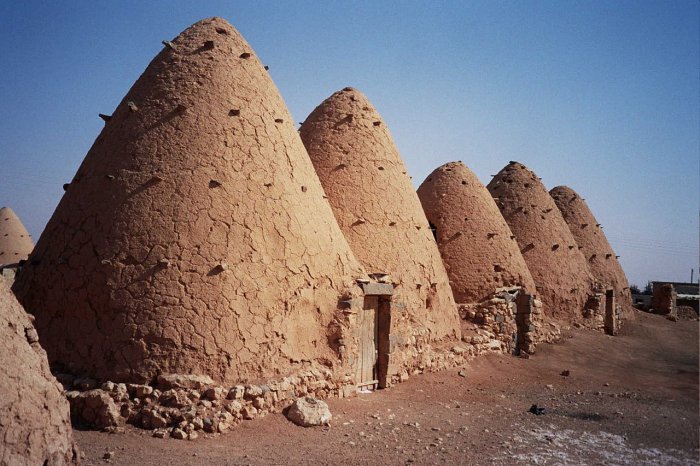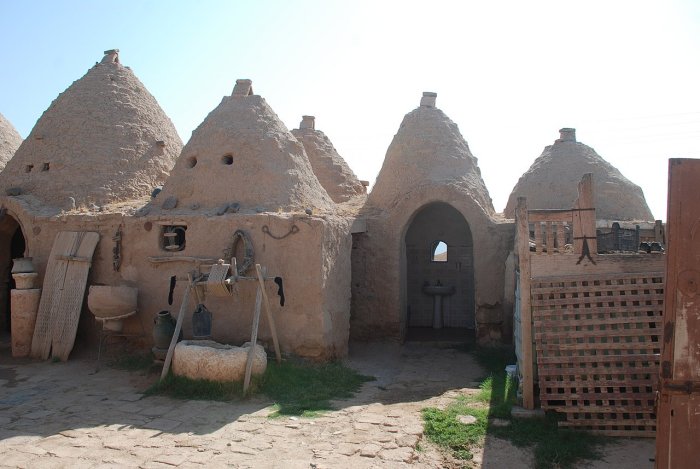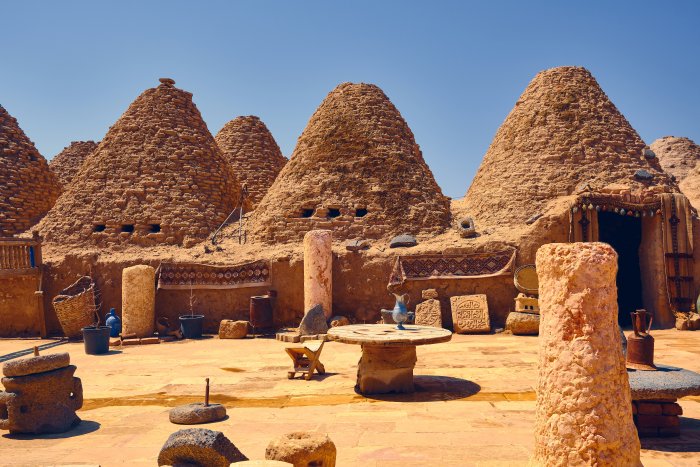Beehive’ Adobe Houses Of Ancient City Of Harran, Upper Mesopotamia
A. Sutherland - AncientPages.om - Harran was an ancient city in Upper Mesopotamia, situated at a crucial geographical crossroad between the Euphrates and Tigris rivers. It had a strategic location at the border between the ancient Mesopotamian and Anatolian cultures.
En Sarouj (Hama). Image credit: upyernoz - CC BY 2.0
The city was famous for the temple of the Moon-god Sin and the defeat of the Roman general Crassus in 53 BC ("Battle of Carrhae"). Today, Harran is famous for its traditional 'beehive' adobe buildings that were cool inside and constructed entirely without wood. Their design has not been changed for at least 3,000 years. The history of the ancient Harran's "beehive" adobe houses goes back in time. Rich is also Harran's history.
The city was founded in an area occupied by two trade routes between Syria, Asia Minor, and Mesopotamia. In this city, Abraham's father, Terah, settled down after leaving Ur. (Leviticus 11:31: the city was called Haran).
From the third millennium BC until medieval times, Harran (in Roman, Carrhae) was an important trade center located on the road from the Mediterranean Sea to the heart of Assyria. Abraham stayed there while on his voyage from Ur
Before the reign of Sennacherib (704–681 BC), the king of Assyria from 705 BC to 681 BC was mainly known for his military campaigns against Babylon and Judah; Harran rebelled against the mighty Assyrians.
Harran dome houses. Image credit: Acar54 - CC BY-SA 3.0
The Assyrians reconquered the city, as mentioned in 2 Kings 19:12 - "Did the gods of the nations that were destroyed by my predecessors deliver them—the gods of Gozan, Harran, Rezeph and the people of Eden who were in Tel Assar? Isaiah 37:12. says that it was deprived of many privileges, which were later restored. The sanctuary of Ehulhul in Harran was later restored by Assyrian rulers like Shalmaneser III ("the god Shulmanu is pre-eminent").
He ruled Assyria (859–824 BC) and was known for his constant and successful campaigns against the eastern tribes, the Babylonians, and the nations of Mesopotamia, Syria, and another prominent figure, Ashurbanipal (668-631 BC). The earliest records of Harran come from Ebla tablets (late 3rd millennium BC).
From these, it is known that an early king or mayor of Harran had married an Eblaite princess, Zugalum, who then became "queen of Harran," whose name was frequently mentioned in ancient documents. It appears that Harran remained a part of the regional Eblaite kingdom for some time.
Royal letters from the city of Mari in the middle of the Euphrates have confirmed that the area around the Balikh river remained occupied in c. the 19th century BC. A confederation of semi-nomadic tribes was especially active around the region near Harran then.
Harran is also mentioned as the provincial capital of the Assyrian empire (until the late seventh century BC). God Sin and his moon sanctuary were closely associated with Harran until the third century CE. But Sin was not the only god worshiped in this ancient city; there were others, such as the Syrian goddess Atargatis, god Sin's consort Ningal, and the Arabian goddess Allat ("Mrs. God").
Beehive homes in Harran, Turkey. Credit: Adobe Stock - Philipp Berezhnoy
Modern people mainly associate Harran with the city's dome-like structures known as “beehive houses.” Wood is rare in the Harran region because of the area's dry climate. People built their houses with materials they could find easily, like adobe, brick, and stone.
The Harran conical houses served people for a very long time. They first appeared around 3000 years ago.
The beehive homes are wonderfully cool places in the desert heat. Their thick mud brick (adobe) walls effectively trap the cool and, at the same time, keep the sun out. Beehive homes have few windows.
The high domes collect the hot air, moving it away from the ground floor, keeping the interior around 75°F (24°C) while outside extremes range from 95°F (35°C) to 32°F (0°C). Each dome is built from approximately 1,400 adobe bricks. The nomadic lifestyle and the climatic conditions forced people to adopt a building form that could be constructed easily, like a tent, but perfectly resists heat and cold.
The roofs have a high heat capacity (the ability to store heat) to absorb the sun's rays during the day and slowly release it to the interior during the cool night. The roof slopes steeply to shed the occasional but heavy rains.
Julian Huxley, the traveler and author, described beehive homes as built of "unburnt mud or clay, with the floor slightly raised above the soil outside, spotlessly clean, with a recess for cooking and attractive decorations in bright tinsel paper on the walls. Though only a few yards in diameter, its high conical roof gave it a sense of space".
The beehive homes survived for thousands of years. They constitute a genius design of ancient people who knew how to build to resist the stresses of strong winds and withstand earthquakes, strong wind, storms, and heavy seasonal rains. It is the reason why these buildings are still in use today.
Written by – A. Sutherland - AncientPages.com Senior Staff Writer
Updated on February 4, 2024
Copyright © AncientPages.com All rights reserved. This material may not be published, broadcast, rewritten or redistributed in whole or part without the express written permission of AncientPages.com
Expand for referencesReferences:
W.F. Albright, Institute of Archaeological Research in Jerusalem. Symbiosis, Symbolism, and the Power of the Past
http://naturalhomes.org/
Lipschitz O. The Fall and Rise of Jerusalem
More From Ancient Pages
-
 Archaeological Evidence That Has Been Suppressed In The Name Of ‘Scientific Conformity’
Featured Stories | Sep 4, 2014
Archaeological Evidence That Has Been Suppressed In The Name Of ‘Scientific Conformity’
Featured Stories | Sep 4, 2014 -
 Native Americans’ Visions Of Distant Explorers May Unravel Some Ancient Mysteries Of North America – Archaeological Evidence – Part 2
Ancient Mysteries | Nov 21, 2019
Native Americans’ Visions Of Distant Explorers May Unravel Some Ancient Mysteries Of North America – Archaeological Evidence – Part 2
Ancient Mysteries | Nov 21, 2019 -
 Roman Ship Cargo And Galley Equipment Discovered Underwater In The Caesarea Harbor
Archaeology | Sep 12, 2023
Roman Ship Cargo And Galley Equipment Discovered Underwater In The Caesarea Harbor
Archaeology | Sep 12, 2023 -
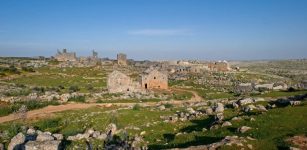 Dead City Of Serjilla – Byzantine Village In Syria Struggling To Survive The Middle Of A War Zone
Featured Stories | Jan 27, 2020
Dead City Of Serjilla – Byzantine Village In Syria Struggling To Survive The Middle Of A War Zone
Featured Stories | Jan 27, 2020 -
 Anglo-Saxon Warlord’s Grave: Archaeologists And Metal-Detectorists Work Together
Archaeology | Oct 7, 2020
Anglo-Saxon Warlord’s Grave: Archaeologists And Metal-Detectorists Work Together
Archaeology | Oct 7, 2020 -
 Ghostly Appearance Of Weird Ancient City Suspended In The Sky Witnessed By Many People
Ancient Mysteries | Jul 9, 2019
Ghostly Appearance Of Weird Ancient City Suspended In The Sky Witnessed By Many People
Ancient Mysteries | Jul 9, 2019 -
 Unlocking The Secrets Of Lost Prehistoric Land Hidden Beneath The Sea
News | Sep 8, 2015
Unlocking The Secrets Of Lost Prehistoric Land Hidden Beneath The Sea
News | Sep 8, 2015 -
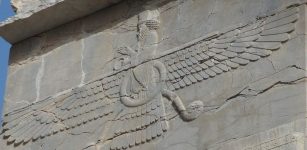 Winged Sun Disk: One Of The Oldest And Most Important Solar And Religious Symbols
Ancient Symbols | Mar 15, 2019
Winged Sun Disk: One Of The Oldest And Most Important Solar And Religious Symbols
Ancient Symbols | Mar 15, 2019 -
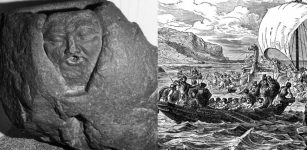 Ancient Mysteries Of Chicago: Is The Puzzling Waubansee Stone A Neglected Pre-Columbian Artifact?
Artifacts | Mar 4, 2017
Ancient Mysteries Of Chicago: Is The Puzzling Waubansee Stone A Neglected Pre-Columbian Artifact?
Artifacts | Mar 4, 2017 -
 DNA Study Suggests Human Language Emerged 135,000 Years Ago
DNA | Mar 14, 2025
DNA Study Suggests Human Language Emerged 135,000 Years Ago
DNA | Mar 14, 2025 -
 Apalala: Harsh Dragon Controlling Swat River Who Became Benevolent Naga King Helping People In Buddhist Tradition
Myths & Legends | Jan 26, 2022
Apalala: Harsh Dragon Controlling Swat River Who Became Benevolent Naga King Helping People In Buddhist Tradition
Myths & Legends | Jan 26, 2022 -
 Ancient European Languages Shed Light On A Great Migration And Weather Vocabulary
Archaeology | Aug 14, 2023
Ancient European Languages Shed Light On A Great Migration And Weather Vocabulary
Archaeology | Aug 14, 2023 -
 Earliest Record Of An Aurora Discovered In The Bamboo Annals
Archaeology | Apr 15, 2022
Earliest Record Of An Aurora Discovered In The Bamboo Annals
Archaeology | Apr 15, 2022 -
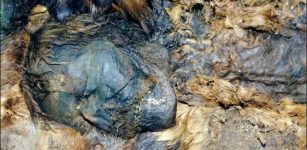 Discovered Near Arctic: Mysterious Lost Medieval Civilization And Puzzling Ancient Mummy
Archaeology | Jul 4, 2015
Discovered Near Arctic: Mysterious Lost Medieval Civilization And Puzzling Ancient Mummy
Archaeology | Jul 4, 2015 -
 Dangerous Anomaly Inside Mysterious European Mountain Remains Unexplained – Examining Evidence – Part 2
Ancient Mysteries | Mar 17, 2021
Dangerous Anomaly Inside Mysterious European Mountain Remains Unexplained – Examining Evidence – Part 2
Ancient Mysteries | Mar 17, 2021 -
 New Clues To Behavior Of Neanderthal Hunting Parties
Archaeology | Mar 27, 2023
New Clues To Behavior Of Neanderthal Hunting Parties
Archaeology | Mar 27, 2023 -
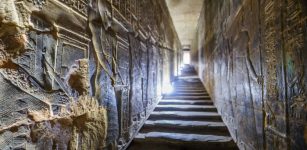 What Happened To The Staircase In The Temple Of The Goddess Hathor?
Civilizations | Mar 9, 2017
What Happened To The Staircase In The Temple Of The Goddess Hathor?
Civilizations | Mar 9, 2017 -
 Mystery Of Count St. Germain – He Claimed To Have Lived For Several Centuries
Ancient Mysteries | Sep 4, 2014
Mystery Of Count St. Germain – He Claimed To Have Lived For Several Centuries
Ancient Mysteries | Sep 4, 2014 -
 Did The Plague Of Athens Come From Egypt Or Is It A Myth?
Archaeology | Dec 13, 2023
Did The Plague Of Athens Come From Egypt Or Is It A Myth?
Archaeology | Dec 13, 2023 -
 Mesoamerican Rubber Ball Game Tradition Existed Earlier Than Thought
Ancient Traditions And Customs | Mar 17, 2020
Mesoamerican Rubber Ball Game Tradition Existed Earlier Than Thought
Ancient Traditions And Customs | Mar 17, 2020

